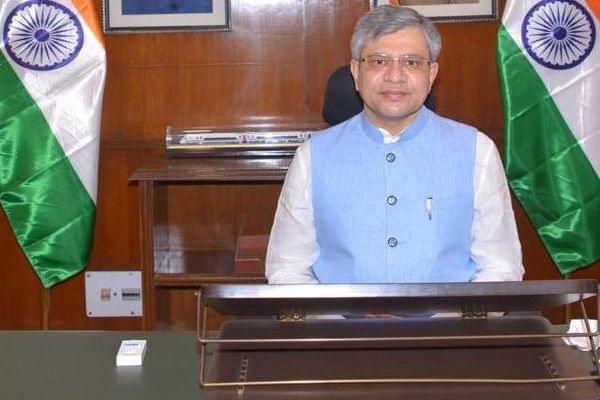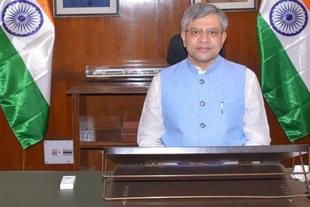Technology
Memo To New MeitY Ministers: Current IT Rules Are Impractical; Focus Should Be On Barring Tech Giants From Censoring
Arihant Pawariya
Jul 10, 2021, 08:07 AM | Updated 08:07 AM IST
Save & read from anywhere!
Bookmark stories for easy access on any device or the Swarajya app.


In the latest cabinet reshuffle by Prime Minister Narendra Modi, the Ministry of Electronics and Information Technology (MeitY) has got the biggest shot in the arm with two accomplished technocrat-entrepreneurs Ashwini Vaishnav and Rajeev Chandrasekhar as new bosses.
Vaishnav, a former IAS officer with degrees from IIT Kanpur and Wharton Business School and armed with experience of heading important arms of multinational companies like General Electric and Siemens will head the ministry where he will be assisted by Minister of State Chandrasekhar who studied Computer Science at Illinois Institute of Technology, worked in Silicon Valley in Intel’s team that designed the famed Pentium chip and built India’s then largest cellular network with BPL mobile which he founded in 1994.
Understandably, expectations are very high from the talented duo as India is striving to become the world’s electronics factory with the help of pathbreaking Production Linked Incentive scheme, aiming to setup semiconductor fabrication plants at home and groping with ways to tackle the huge challenge posed by social media monopolies like Google, Facebook, Amazon, Twitter etc., whose actions of late have undermined the authority of India’s state as the sole sovereign of its people.
In light of these challenges, Modi sarkar couldn’t have picked better talent than these two to lead this important department. While becoming global leader in electronics manufacturing and semiconductor fabs are long term projects, devising rules to deal with tech giants is of more immediate concern.
The helplessness displayed by the previous MeitY minister Ravi Shankar Prasad in taking some concrete action against Twitter may give an impression that the Information Technology Act of 2000 is insufficient in dealing with these social media platforms which have become de facto publishers at large. Usually, there is no dearth of laws in India and the authorities are usually found slacking in the implementation of existing legislation.
Is that also the case with respect to the IT Act especially after the publication of Information Technology (Guidelines for Intermediaries and Digital media ethics code) Rules, 2021 which came into force last month?
Part II of the rules under the heading ‘Due diligence by Intermediaries’ specifically deals with the digital platforms such as Twitter, Facebook, Google, WhatsApp, YouTube, etc (which have been categorised as ‘significant social media intermediaries’).
These ‘significant social media intermediaries’ are bound by additional regulations apart from the ones which govern the functioning of intermediaries. These include appointing Chief Compliance Officer, Nodal Person, Resident Grievance Officer, identifying first originator of information in case of messaging apps, marking content as advertised or sponsored if it’s paid promotion, publish periodical reports of compliance among other things.
The fact that the likes of Twitter have not even appointed required officials and the tussle with the government over these low hanging fruits has led many to believe that this is all that is there in the IT rules. This is not the case. As far as implementation is concerned, the government has barely scratched the surface.
Below are few examples of what the IT Rules of 2021 mandate for intermediaries failing which government can take action (including fine and imprisonment).
First, section 4, clause (k) under Part II states that ‘The intermediary shall not knowingly deploy or install or modify technical configuration of computer resource or become party to any act that may change or has the potential to change the normal course of operation of the computer resource than what it is supposed to perform thereby circumventing any law for the time being in force’.
The language is vague here. Does it effectively bar intermediaries from acting as publishers by using various opaque algorithms to stifle reach of some accounts while allowing others a free run? It’s not clear. So far, the discussions have revolved around tech giants losing their intermediary status and in turn the protection offered from legal action against the content published on their platforms. But what if the government uses this clause to take away any right of the intermediaries to act as publishers in the first place?
This takes us to the second important clause which basically lays down rules for how the intermediaries may censor the content on their platform.
Second, under Part II, Rule 5, sub-rule 8 makes censoring a more difficult process.
Where a significant social media intermediary removes or disables access to any information, data or communication link, under clause (b) of sub-rule (1) of rule 3 on its own accord, such intermediary shall,— (a) ensure that prior to the time at which such intermediary removes or disables access, it has provided the user who has created, uploaded, shared, disseminated, or modified information, data or communication link using its services with a notification explaining the action being taken and the grounds or reasons for such action; (b) ensure that the user who has created, uploaded, shared, disseminated, or modified information using its services is provided with an adequate and reasonable opportunity to dispute the action being taken by such intermediary and request for the reinstatement of access to such information, data or communication link, which may be decided within a reasonable time; (c) ensure that the Resident Grievance Officer of such intermediary maintains appropriate oversight over the mechanism for resolution of any disputes raised by the user under clause (b).
If the intention of the government was to bar the intermediaries from playing publishers, then there was no need to lay down elaborate ground rules for censoring. Some might want to argue that this censoring is in relation to the orders passed by the court or the government but for such requests, others clauses have adequately dealt with in depth.
Third, the rules devise an elaborate mechanism where intermediaries have been tasked to acknowledge the receipt of complaints from users within 24 hours (to be done by none less than the Grievance officer) and then resolve them within 15 days (under sub-rule (2) of rule 3) and enable the complainant to track the status of such complaint or grievance by providing a unique ticket number for every complaint or grievance received by such intermediary (under sub-rule (6) of rule 4).
This is in addition to all the requests that the intermediaries have to comply with from the law enforcement agencies and the government departments. Given the number of users, it would be practically impossible for any intermediary to adhere to these rules even if they hire an army of employees to execute it. It seems that the rules have been framed to ensure non-compliance and create numerous loopholes to punish intermediaries than come up with a decent mechanism that is aimed at resolving genuine problems.
Fourth is sub-rule 7 of rule 4 under Part II which mandates that all the intermediaries enable all Indian users to voluntarily verify their accounts and such users are ‘provided with a demonstrable and visible mark of verification, which shall be visible to all users of the service’. This mark which should be given to all valid users upon verification has been turned into a status symbol by these social media companies which dole it out to the ones they like and deny to those they don’t like on completely arbitrary criteria.
The challenge before the new ministers is to come up with practical IT rules that are devised to remove the arbitrariness and discrimination by the intermediaries. The rules should be simple, not vague, and easy to comply with. The fact that they are not lawyers is an asset which can come in handy. The goal is to solve the problem and not increase litigation and fighting in courts.
So what should be done?
Simply bar the significant social intermediaries from exercising any editorial control except on directions from the government to take down content which is illegal as per Indian laws. Publishers can be allowed some leeway.
This would mean that YouTube can’t legally take down videos of anyone. But Netflix can choose to have anyone on board and de-platform someone it doesn’t like. The former‘s content is user-generated, not the latter’s.
Ditto for Facebook, Twitter, Quora, Google, etc which will be classified as ’significant social media intermediaries’ while Amazon Prime, Hotstar, etc, can choose to host whatever and whoever they want.
All other rules should be framed around this principle. Complicating things with overarching rules will only make matters worse.
Arihant Pawariya is Senior Editor, Swarajya.





